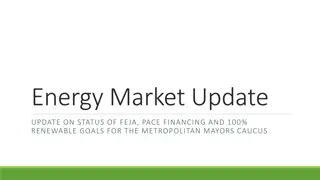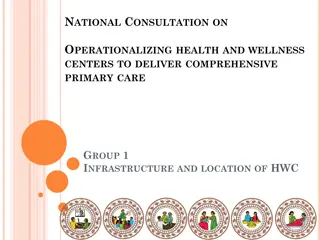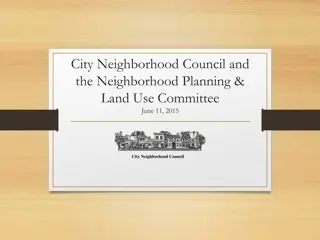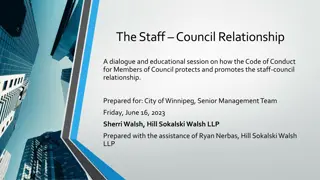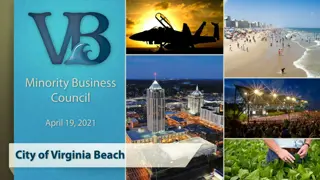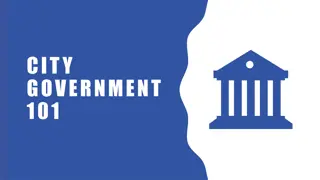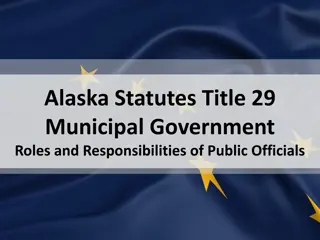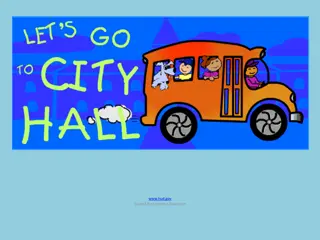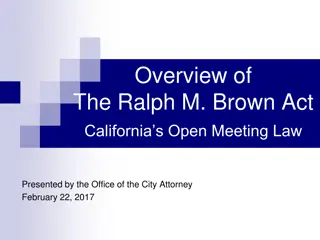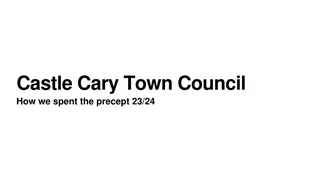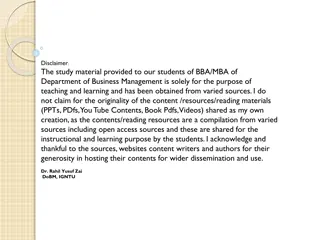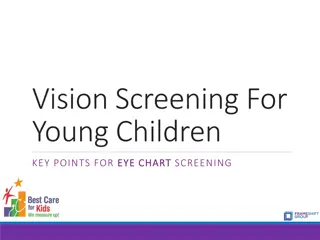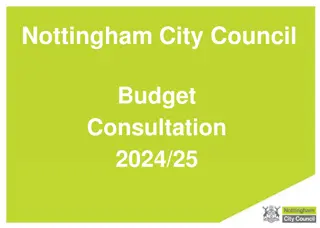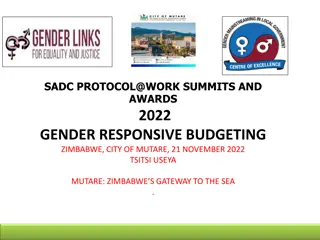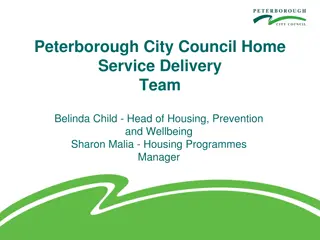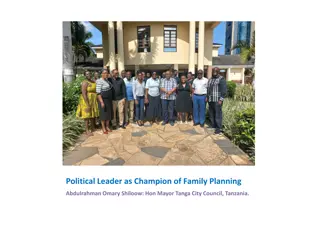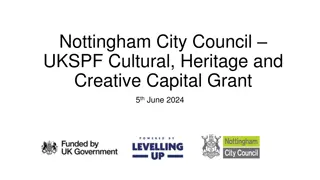Operationalizing Mayor's Vision for Freetown City Council
Freetown, a city with vast potential, faces significant challenges across various sectors and is at risk of natural disasters. With Mayor Yvonne Aki-Sawyerr leading the way, the focus is on transforming Freetown under themes like social services, job creation, and environmental management to improve the lives of its residents. Collaboration between the local and central government aims to make Freetown a thriving destination city.
- Freetown City Council
- Mayors Vision
- Urban Development
- Infrastructure Management
- Collaborative Governance
Download Presentation

Please find below an Image/Link to download the presentation.
The content on the website is provided AS IS for your information and personal use only. It may not be sold, licensed, or shared on other websites without obtaining consent from the author. Download presentation by click this link. If you encounter any issues during the download, it is possible that the publisher has removed the file from their server.
E N D
Presentation Transcript
Freetown City Council Operationalizing the Mayor s Vision 16th May 2018
Freetown has enormous potential as a city but faces severe challenges across all sectors and is at an increased risk of natural disasters About 95% of Freetown s population not About 95% of Freetown s population not served by the water supply utility; the entire served by the water supply utility; the entire city outside the Central Business District city outside the Central Business District served by septic tanks, pit and bucket served by septic tanks, pit and bucket latrines; urban mobility severely impaired by latrines; urban mobility severely impaired by poor infrastructure, poor management of poor infrastructure, poor management of road space, inadequate public transport and road space, inadequate public transport and a weak institutional and regulatory a weak institutional and regulatory framework framework Freetown has over 1.0 million residents, and has been growing at 3.01 percent per annum since 1985 The unique ecological, aesthetics and recreational resources of the natural environment of Freetown are extraordinarily high, but are threatened and are at risk of loss The absence of an adequate waste management system negatively impacts residents health and environmental sustainability With 40 percent of Sierra Leone s urban population, Freetown is host to the national government s legislative, executive and judicial branches as well as foreign embassies and consulates The expansion of the footprint or built-up area beyond Freetown s municipal boundaries started in 2000s, and has expanded by almost by a third. The importance of Freetown to Sierra Leone s economy is clear, with the city The importance of Freetown to Sierra Leone s economy is clear, with the city creating 30% of the country s GDP despite housing only 15% of its population. creating 30% of the country s GDP despite housing only 15% of its population.
In the recent local elections addressing these issues were at the heart of the mayoral campaign for the Freetown City Council Yvonne Aki-Sawyerr was elected as the Mayor of Freetown in the local government elections that were conducted on 7th March 2018. Her campaign was based on the transformation of Freetown under the themes outlined below and with the 14 related sectors/areas of focus as set out in her vision statement: Themes F Wi K myuniti F Wi Progr s F Wi Frit ng focusing on delivery of social services focusing on job creation focusing on the built infrastructure and environmental management The Mayor s sectors/areas of focus are aligned with key areas of focus of the newly elected central government s New Direction Manifesto Therefore the successful operationalization of the Mayor of Freetown s vision statement will directly complement the development efforts of the new central government
Working in collaboration with central government and the people of Freetown, the vision is to improve the lives of all Freetonians and to make Freetown a destination city TRANSFORMING OUR CAPITAL CITY .THROUGH CONCRETE ACTIONS Improve quality of primary to mid-secondary education with increased investment in teachers, educational facilities and schools supervision Significantly increase FCC revenue generation to facilitate provision of improved public services F Wi K myuniti Ensure efficient and effective collection of appropriate property rates, local taxes, licenses, fees and other charges Improve quality of primary and secondary healthcare by strengthening community healthcare workers, increasing public health awareness and access to diagnostic facilities Align development partner initiatives with the city s vision and priorities Enhance citywide sanitation through the design and implementation of a comprehensive end to end waste management strategy Provide adequate designated covered and open markets with appropriate facilities Improve housing conditions including facilitating the provision of affordable social housing Provide opportunities for people with disabilities to live independently Facilitate sustainable job creation through enterprise development and private sector partnerships Harness opportunities created by current water and energy sector investments to develop and increase the manufacturing base and service industries F Wi Progr s Invest in skills development including adult education and technology Invest in and preserve cultural heritage sites and capitalise on natural beauty of the city to develop tourism Improve public transport provision Ensure timely and adequate road maintenance Promote Made in Sierra Leone and Local Content Policies that support job creation
The Mayors vision statement continued TRANSFORMING OUR CAPITAL CITY .THROUGH CONCRETE ACTIONS Accelerate the beautification of Freetown, including the provision of additional recreational and green spaces Introduce a comprehensive environmental protection strategy to include tree and shrub planting that will mitigate against soil erosion, silting and flooding F Wi Frit ng Raise awareness of environmental issues and strengthen environmental protection Geo-map the city to support appropriate land use planning Introduce car parks and enforce parking regulations Foster civic responsibility and community ownership of ward level development Strengthen the Freetown Metropolitan Police to ensure compliance with FCC By-laws Disaggregate citywide development targets to ward level, provide ward level resources to implement initiatives and monitor and track ward level performance covering 14 Priority Sectors Education Health Solid Waste Management Housing Water Disabilities Revenue Mobilisation Private Sector Development & Job Creation Skills Development Transportation Road Maintenance Traffic Management Environmental Management Urban Planning (including Markets & Street Trading)
The determination of targets and the development of interventions in the priority sectors will be underpinned by 5 cross-cutting principles Environmental Management Urban Planning (inc markets & street trading) Revenue Mobilisation Resilience INNOVATION Education Skills Development Disability Private Sector Development (Tourism focus) Human Development Health Water Sanitation Housing Healthy Cities Transportation Traffic Management Road Maintenance Urban Mobility
Key features of the proposed implementation approach for delivering results in the priority sectors were set out in the Mayor s vision statement: Consultative validation by Freetonians A ward focused, data driven system with strong performance management Changes are required to bring improvements to Freetown and to the lives of Freetonians. It is critical that the vision that drives those changes is a shared vision. As Mayor of Freetown, Yvonne will lead a consultation process with all Freetonians so that we together agree on the future we want for ourselves and for our city FCC will utilise the delivery approach to prioritise and develop specific initiatives with concrete, measurable targets at citywide and ward levels. A strong performance management system with effective external and internal communication will ensure a heightened level of transparency and accountability Consultation & Vision Setting Performance Management Delivery Planning Prioritization
4 concurrent work streams are required to deliver confidence-building and priority quick wins, a validated vision statement and the phased 4 year implementation plan Month 1 Month 2 Month 3 Week 1.5 Continued implementation of 4 year plan Initial work streams Mayor s start date Development of plans and budgets for immediate but limited sector initiatives Development & implementation of plans for Flood Mitigation, CBD Beautification and Revenue Mobilisation (this immediate initiative does not replace the comprehensive solutions that will be developed under work stream 3) 1 Council Orientation Review of current revenue mobilization, service delivery functions & activities Review of capital & human resources and physical assets Review of existing contracts, projects and programmes FCC situation review: resource and process mapping and analysis 2 Development of fact files and databases with Councilors, significant stakeholders and priority area working groups to build detailed plans & budgets Vision validation, prioritization and sector initiatives development and implementation plans Consultations with Freetonians via radio, social media and ward level meetings 4 Year Phased City Plan 3 Confirmation of objectives & structure of Delivery Unit Establishment of the Mayor s Delivery Unit Fundraising for Mayor s Delivery Unit and first 24 month sector initiatives 4
Delivering solutions for the Western Area through a partnership between the Freetown City Council and Western Area Rural Council The Western Area has a population of ~1.5million people: Western Area Urban (1,055,964 people) Western Area Rural (444,270 people) The Western Area comprises Western Area Urban (Freetown Municipality) and Western Area Rural. With Western Area Rural (mountain communities of Regent, Leicester etc and peninsular communities of Goderich, Hamilton, Tombo etc) physically surrounding Western Area Urban, the development challenges faced by these two districts are intrinsically intertwined. The Freetown Mayor and the Western Area Rural District Council Chairman and their respective councils are committed to working in close collaboration to develop lasting and effective solutions for Freetown and Western Area Rural
The transformation of Freetown needs all hands on deck and partners & the private sector have an opportunity to engage in several capacities Work streams Opportunities for partners and private sector engagement Flood mitigation activities provision of financial support; provision of logistical support (e.g. front end loaders; bulldozers; trucks) Development of plans and budgets for immediate but limited sector initiatives 1 CBD beautification bye-law compliance re frontages; sponsorship of green space creation; sponsorship of street bins; sponsorship of roundabout designs; other FCC situation review: resource and process mapping and analysis Mayor s Delivery Unit support (see below) 2 Consultation and prioritization process participation in ward based town hall meetings Vision validation, prioritization and sector initiatives development and implementation plans 3 Priority sector target setting and development of initiatives participation in relevant priority sector working group sessions to set targets, develop initiatives and produce 4 year city plan; venue for group sessions provision of appropriately skilled secondees to the MDU; financial support to cover hire of MDU staff member (s) for 12 or 24 months; volunteer participation in MDU to facilitate FCC situation review and/or priority sector initiative implementation Mayor s Delivery Unit (MDU) support Establishment of the Mayor s Delivery Unit 4
Appendix: Delivery approach to be utilized in respect of the 4 year implementation plan developed in Work Stream 3
Priority initiatives will lead to the delivery of concrete results under each sector area. Milestones will help us track those initiatives WORK STREAM 3 Sector Area Goals will be driven by initiatives, sub-initiatives, and detailed activity plans Example structure Priority Sector Target Each priority sector will have a concrete target, that will be achieved by limited number of specific priority initiatives Each initiative will be tracked by SMART indicators to measure overall results. Where needed, they will be broken down into sub-initiatives to support detailed planning. Initiatives Initiatives Priority Initiatives Planning for each sub-initiative is done at the milestone and activity levels Each activity includes details on: Activities Activities Milestones Start / End dates Responsible person Responsible Implementing Partner & person Ward Sub-initiative Activities Activities Activities Activities Milestones Milestones Milestones Sub-initiative Activities Detailed activity plans are developed and documented in 3 month cycles
Implementation will be internally and publicly tracked for completion, performance, and accountability WORK STREAM 3 Each priority sector will have selected performance metrics which will be reported on regularly for accountability and early issue identification. Key Performance Indicators (KPIs) and Delivery Indicators (DIs) monitor success within the priority sector, both to achieve the end goal and in terms of implementation Dashboards will be used to show overall progress against the plans and targets Tracks the overall strategic goal for the sector Helps measure whether we are doing the right activities to meet the overall target Priority Sector Key Performance Indicator (KPI) Priority Initiative Monitors the delivery of a single sub-initiative Keeps track of how we are doing at implementation Sub-initiative Delivery Indicator (DI) Milestone Activity


